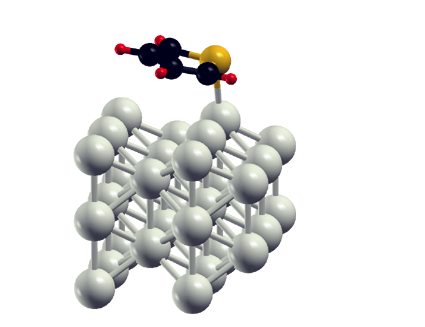
Project 14 – Ab-initio study of organic filmsClaudia Ambrosch-Draxl, ao.Univ.Prof.Mag.Dr.Dr.h.c. The main goal of the project is a first-principles study on the conformation and orientation of molecules in organic thin films. Thereby the surface terminations will be investigated as well as the interfaces with different substrates. The former investigations will be dedicated to questions concerning surface energies and surface reconstructions. The latter will deal with various kinds of interfaces, ranging from a single molecule on top of a substrate, via low coverage up to mono- and multi-layers. Moreover, also different polymorphs of molecular crystals, which are usually present in organic films, will be studied in their bulk structure. These studies will give information on the structural properties and growth conditions. Besides, the corresponding physical properties will be calculated for all these structures. They will comprise electronic properties (band structures, effective masses, etc.), optical properties as well as vibrational frequencies and eigenvectors. The molecules of investigation will be the oligophenyls (nP, where n stands for the number of phenyl rings), the oligothiophenes (nT), the oligoacenes (nA), and other molecules depending on the progress of the project and the needs from experimental side. The methods will be based on density functional theory, where the linearized augmented planewave method as well as the projector-augmented planewave method will be applied. The latter will also be used for Car-Parinello molecular dynamics.  PRESS RELEASENanoscience: Weak Force. Strong Effect. The van der Waals force, a weak attractive force, is solely responsible for binding certain organic molecules to metallic surfaces. In a model for organic devices, it is this force alone that binds an organic film to a metallic substrate. This data, recently published in Physical Review Letters, represents the latest findings from a National Research Network (NRN) supported by the Austrian Science Fund FWF. These findings mean that numerous calculation models for the physical interactions between thin films and their carrier materials will need to be revised. Although they fulfil complex functions when used, for example, as computer chips, inorganic semiconductors have a simple construction that greatly limits their application. The same does not apply to semiconductors made of organic materials. Because organic molecules are extremely flexible, they can be used in a whole new range of applications. However, before this advantage can be exploited to the full, scientists need to have a better understanding of the far greater complexity of these materials over their inorganic counterparts. Up & Down Organic semiconductors are manufactured by applying thin films of an electrically conductive organic material to a carrier surface. When carrying out this process, it is important to understand the interactions that occur at the interfaces between the carrier material and the organic material. A team from the "Interface controlled and functionalised organic thin films" National Research Network (NRN) at the University of Leoben has made an important contribution to scientific understanding in precisely this field. Using complex calculations, the team has been able to show that a thin film of organic thiophene is held on to a copper surface solely by the van der Waals force. The team calculated that the adsorption energy involved is -0.50 eV. The spokesperson for the NRN, Prof. Helmut Sitter from the Institute of Semiconductor and Solid State Physics at Johannes Kepler University (JKU) in Linz, explains: "The van der Waals force is a weakly interacting force between atoms that occurs as a result of asymmetric charge distribution in atoms. We now know that this exerts a highly significant influence on the kinds of extremely thin material films used to manufacture organic semiconductors. Indeed, this force can successfully bind the materials entirely on its own. However, due to its weakness, several previous methods used to calculate the interactions between different materials have attached only minor importance to this force, or have ignored it altogether." This would also seem to provide some explanation for why the generalized gradient approximation (GGA) often used in such instances has been unable to satisfactorily explain the bonding behaviour in thin layers. In fact, these newly published results could explain the discrepancies that have long been found between various experimental data and models for calculating the interaction between thin layers. Publications, Prizes, Products The new data adds to our fundamental understanding of the interactions that take place at interfaces. The influence of the van der Waals force also indicates that no charge is transferred between the atoms of the organic materials and their substrates in the calculated system. This finding is of key significance to the production and functionality of organic semiconductors. Several articles in the Advanced Materials journal this year demonstrate how research carried out by members of the NRN maintains a steady focus on practical applications. As a result of one such article, the Institute of Experimental Physics at JKU won the official Innovation Prize of the Province of Upper Austria. It is no surprise that three spin-off companies – run almost exclusively by graduates from the Institutes involved in the NRN – have already been established as a direct result of the findings. One of these companies, Nanoident, was declared "Entrepreneur of the Year 2007" by Ernst & Young Austria. Prof. Sitter believes that all of these achievements, together with an article by the NRN published in SCIENCE in the summer of this year, prove how this National Research Network has successfully combined fundamental research, applied research and technology transfer – with the support of the FWF. Original publication: Importance of Van Der Waals Interaction for Organic Molecule-Metal Junctions: Adsorption of Thiophene on Cu(110) as a Prototype, P. Sony, P. Puschnig, D. nabok & C. Ambrosch-Draxl. Phys. Rev. Lett. 99, 176401 (2007). Scientific contact: Austrian Science Fund FWF: Copy Editing and Distribution: |


Page last modified on August 26, 2008, at 11:18 PM